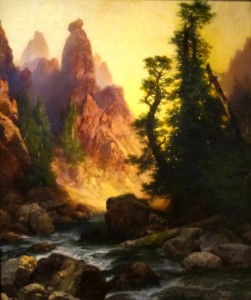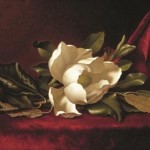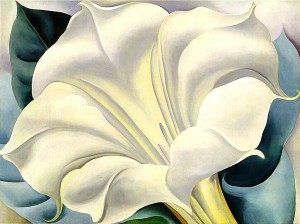The Most Famous Supper in History
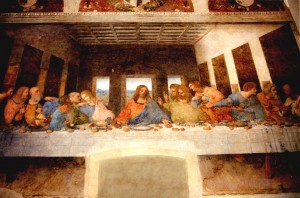
The Last Supper, c. 1495
Wall painting, Leonardo da Vinci
Leonardo da Vinci captured the moment in which Jesus makes the staggering announcement that he will be betrayed by one of His disciples. This is the last supper they will share.
He is indeed betrayed by Judas Iscariot that same night.
He is crucified by Pontius Pilate.
He rises from the dead three days later.
And the world is changed forever.
Artists have expressed their own versions of The Last Supper for over 500 years.
Their interpretations are profound, enlightened, mysterious, and humorous.
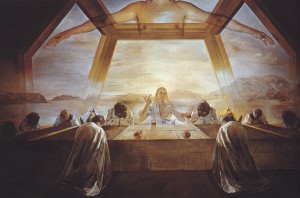
The Sacrament of the Last Supper, 1955
Oil on canvas, Salvador Dalí

The Last Supper, 1940
Oil on canvas, Frida Kahlo

Jesus Is My Homeboy: Last Supper, 2003
Photograph, David LaChapelle
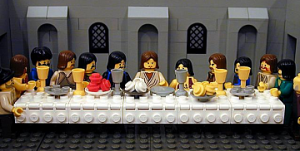
The Last Supper, 2005
Legos, The Brick Testament

iLastSupper
You won’t believe the tumultuous life of The Last Supper!
Click here if unable to view the video.
The Art That Hitler Hated
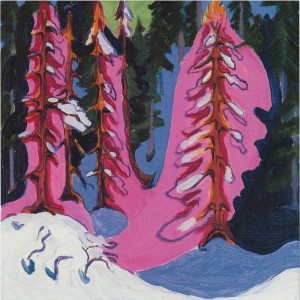
At the Forest Edge, 1936
Ernst Ludwig Kirchner
“Anybody who sees and paints a sky green and pastures blue ought to be sterilized.” Adolph Hitler
_______________
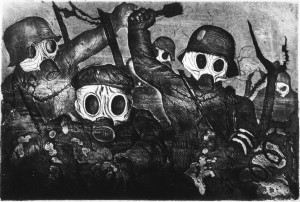
Stormtroops Advance Under Gas, 1924
Otto Dix
“Any art that does not glorify war is forbidden.” Nazi propaganda
_______________
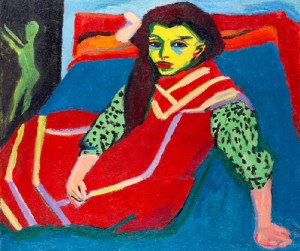
Sitting Girl, 1910
Ernst Kirchner
“Garish colors and contorted poses of the female body are evidence of a depraved society.” Nazi propaganda
_______________
German art changed spectacularly after 1920. No longer did artists paint the classical Greek model.
The horrors of World War I, the terrible economic depression, prostitution, the chasm between the rich and the poor…all were bitterly protested in art.
German artists used bright garish colors, awkward poses and harsh brush strokes to shock the viewer with Germany’s tragic plight.
German Expressionism was born!
As a young man Adolph Hitler was refused admittance to art school in Vienna, Austria, on the basis of his lack of artistic ability. He never recovered from the rejection.
Hitler denounced German Expressionist artists and their extremely colorful paintings as “degenerate.” They were evidence of a pollution in the Aryan strain. The artists who produced them were fired from their teaching positions, their works were removed from museum walls, and they were forbidden to paint again.
Some of these “degenerate” artists escaped to other countries, many of their works were hidden for years or secretly smuggled to America, and many, many works were burned.
Today German Expressionism is considered a momentous time in German art history, the paintings are back on museum walls and “degenerate” art is celebrated over the world.
Watch this video with wild colors and startling paintings-German Expressionism.
Click here if unable to view video.
Cornelia Feye, art historian, talks more on German Expressionism.
Click here if unable to view the video.
3 Famous Outsider Artists
Outsider Art:
Naive…visionary…never been in an art school or gallery…disturbing images…
DELIGHTFUL!
_______________

Wash Day, 1950
Cementine Hunter
Oil on pasteboard.
First impression of Clementine Hunter’s paintings: charming, quaint, life on the plantation.
But, look deeper into these child-like paintings of picking cotton, picking pecans, washing clothes, baptisms and funerals.
Even though she was born in 1886, twenty years after the Civil War, segregation and oppression of the blacks was still rampant. These paintings are gentle images of this oppression.
What a story! Clementine spent much of her life working on a plantation in Louisiana and only attended school for ten days, never learning to read or write. While she was working as a house servant, an artist visiting the plantation left some discarded brushes and tubes of paint. She became intrigued and used the brushes to “mark a picture, or a window shade.” Clementine Hunter’s career as an artist began.
Often referred to as the black Grandma Moses, Northwestern State University of Louisiana granted her an honorary Doctor of Fine Arts degree when she was 100 years old.
_______________
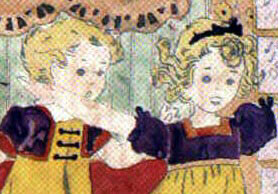
Untitled
Henry Darger
Henry Darger’s story is heartbreaking but he left the world a treasure trove of art.
Tragedy found Henry Darger early and often. When he was 4 yrs old, his mother died. Unable to care for him, Darger’s father placed him in an orphanage. Labeled a troublemaker, the young Darger was moved from institution to institution. At 16, Darger ran away and for the next 64 years he lived alone in a rented room and worked as a janitor in Chicago.
Darger died at 81. His landlords cleaned out his room and made a startling discovery: alone in his room, Darger had created hundreds of beautiful, large paintings illustrating an epic fairytale (15,000 pages) he had written over 60 years.
A brilliant artist, hidden from the world in the guise of a lonely janitor, Henry Darger has become internationally known and is represented in major museums throughout the world.
_______________

Jesus is my Airplane, 1970
Sister Gertrude Morgan
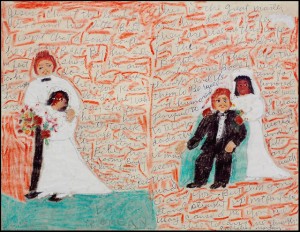
Jesus Christ The Lamb of God and His Little Bride, 1960
Sister Gertrude Morgan
Crayon and ballpoint pen on paper.
Sister Gertrude Morgan (1900–1980) was a poet, a preacher, an artist, and a singer who loved Jesus. She called Jesus her husband, her doctor, and her airplane (yes, airplane), and claimed to have met with him in visions throughout her mid and later life.
Born on a farm in Alabama, in 1900, Sister Gertrude left school after third grade so that she could help her family with the farm work.
Preaching the gospel tirelessly in the streets of New Orleans, Sister Gertrude founded an orphanage and ministered to the sick and inmates of Orleans Parish Prison for years.
Later in life, she said she had had a revelation that she was to be the “little bride of Christ.” This calling she took with great seriousness, dressing solely in white garments for the rest of her life.
After this revelation, Sister Gertrude’s paintings were little figures of herself in a white bridal gown standing beside a pudgy little Jesus wearing a tuxedo. Other images pictured her and Jesus in an airplane flying around heaven. She was adamant that her paintings were divinely inspired and indeed, perhaps they were.
Sister Gertrude died in 1980, at eighty years of age. Her paintings have been exhibited and celebrated in prestigious museums such as the American Folk Art Museum and the Philadelphia Museum of Art.
“Jesus is My Airplane,” sold to a private collector for $20,700.
_______________
Watch Sister Gertrude Morgan in New Orleans.
Click here if unable to view the video.
Fantastical video of Henry Darger’s images and fairytale.
Click here if unable to view the video.
Girl with a Pearl Earring
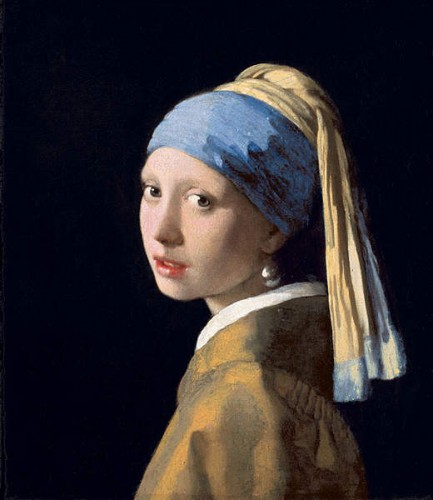
Girl with a Pearl Earring, c. 1665
Johannes Vermeer
Did we just call out her name? Is she turning to us to whisper a secret? We lose ourselves in her gaze, and all of a sudden we feel a quickening of the heart…a charge of energy.
We are in the presence of a masterpiece.
Girl with a Pearl Earring.
Considered one of the most talented painters in the Dutch Golden Age, Vermeer was a genius in enhancing the sense of vibrancy and mystery through his paints.
How did he achieve the intimacy of this smile?
Look closely at the young girl’s mouth. Two small white dots on either side of her mouth, echoes the highlights in her eyes and the light on her pearl earring.
Voila! The young girl’s half smile is enlivened!
How did Vermeer achieve the delicious colors of the turban, the cloak?
The rich blue of her turban: The artist procured the blue rock, lapis lazuli, from Afghanistan traders. He then hand-ground the hard rock to powder making that incredible ultramarine blue.
And her vibrant cloak: Yellow flowers gathered and boiled making that special golden earthy color.
But knowing the “how” dims not at all our reverence for the painting. Returning to that face with the liquid eyes and sensual smile, we once again bask in the delight of being in the presence of a true and timeless MASTERPIECE.
Girl with a Pearl Earring: Dutch Paintings From the Mauritshuis can be seen in a rare traveling exhibit at:
de Young Museum, San Francisco:
January 26 – June 2, 2013
High Museum of Art, Atlanta:
June 22 – September 29, 2013
The Frick Collection, New York:
October 22, 2013 – January 21, 2014
BEHOLD, America!
American art is evolving!
American art is pushing all the boundaries!
It is almost inconceivable how much the work of American artists has changed in the past 250 years. This mind-boggling evolution is brilliantly presented by three renowned San Diego museums…The Museum of Contemporary Art San Diego, The San Diego Museum of Art and the Timken Museum of Art. These classy museums have pooled their art treasures for a knockout show.
BEHOLD, America!
America’s art is presented with the three themes of Figures, Frontiers and Forms; dating from before the revolution in 1771 to the latest contemporary pieces.
See for yourself the evolution!
Figures
Frontiers
Forms
Yes! American art has definitely evolved.
Watch this video for a fascinating glimpse of BEHOLD, America!
Click here if unable to view the video.
Video credit: VideoliciouslybyRuth



